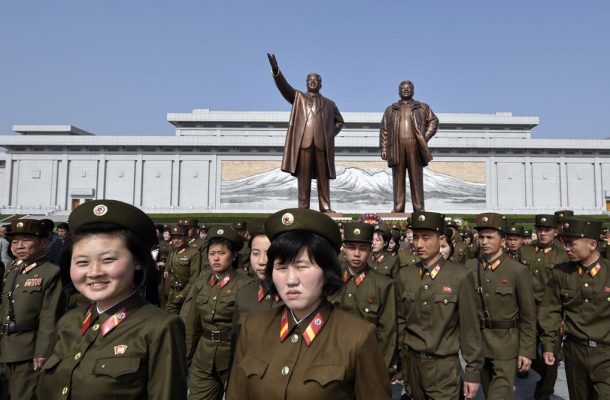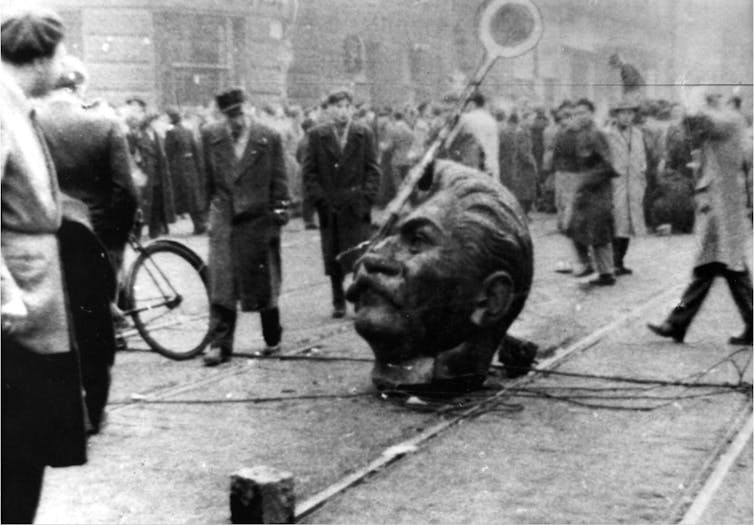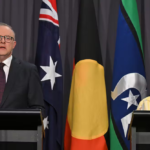A visit to Pyongyang: the Kim dynasty’s homage to Stalinism

Most of the chaperoned tours to North Korea each year include a walk through some well-tended gardens in Pyongyang, where Korean men in nondescript uniforms tend flower beds and manicure lawns without even briefly acknowledging a rare group of foreigners. As my group walked around, we approached a man just as he started to crouch over a flower bed – revealing the Adidas logo on the waistband of his boxer shorts.
As “builder’s bum” moments go, this was as surprising as they come. It was the only time during my five days in the North Korean capital when I saw any kind of corporate branding. Of course, it’s entirely possible that we just happened to walk past at the exact moment he bent over, and that he just happened to be wearing his contraband underwear that day.
But perhaps it was something more: a rare effort by an individual to communicate that the scene in the gardens was staged by the state, part of its efforts to propagate a positive image of North Korea to even the smallest of foreign audiences.
The more I reflect on the tour, the more I realise that everything and everyone we saw was part of a managed performance: the people walking on the streets, commuting, shopping, picnicking, even the children playing football and the other diners in the restaurants. More than that, we spent the whole tour surrounded by images of the Kim family and immersed in the narrative of their achievements.
These are the hallmarks of an autocratic personality cult, the sort of hyperreal quasi-religion cultivated by any number of history’s despots. The most notorious dictator-cultist is of course Adolf Hitler, who elevated himself to demigod status with incendiary rhetoric, vivid architectural and visual spectacle, and even an eponymous salute. But throughout the Cold War, various of North Korea’s Asian neighbours were host to cult-like leaders.
China’s Mao Zedong developed a personal image that legitimised his rule even as his party’s policies caused millions of deaths; on the island of Taiwan, Chiang Kai-shek attempted to solidify the position of his Kuomintang political party with public images of himself following their arrival from the Chinese mainland in 1949. In his 21 years in office, the Philippines’ Ferdinand Marcos spent huge sums of public money on gigantic edifices of himself.
Post-Soviet Central Asia, too, had a number of despots, who have presided over extravagant cults of charisma – not least Turkmenistan’s Saparmurat Niyazov, who renamed the months of the year after himself and his family members.
But there’s one particularly close parallel for the style and strategy of the Kim cult: Stalinism. The Kims have not only learned from his example, but have taken it to a gold-plated extreme.
Man of steel
Around the same time that Hitler was finessing his image, Josef Stalin was also developing a cult of personality around his leadership, both in the Soviet Union proper and in its wider geopolitical sphere of influence.
Stalinism constituted rapid industrialisation, some of which included assistance from the US, collective agriculture, the centralisation of government decision-making, and a cult of personality around Stalin himself. Furthermore, Stalin’s administration consolidated the notion of the Soviet Union as leader of the Communist world.
Stalin commissioned statues of himself to be placed in towns and villages across the country. Various locations around the Soviet Union were renamed to include Stalin’s name, for example “Stalingrad” (now Volgograd), the site of one of World War II’s most pivotal battles. He changed the Soviet national anthem to include his name, and pushed for literature, poetry, music, paintings and film to depict him as a strong, charismatic and devoted leader.
These cultural installations were complemented by swingeing political purges, incarcerations and executions, and the development of a public radio network across the Soviet Union that used loudspeakers to propogate pro-Communist and pro-Stalin narratives.
When puppet states in the Soviet sphere sporadically rebelled during the Cold War, the destruction of solid effigies of Stalin became a set piece of anti-Soviet actions. Perhaps the most renowned is the photograph of the decapitated head of a massive Stalin statue lying on the ground in Budapest during the Hungarian Uprising of 1956. (The spectacle was echoed in April 2003 when a statue of Saddam Hussein was toppled in Baghdad.)

Three years after Stalin’s death, his successor, Nikita Khrushchev, criticised him in what became known as the “Secret Speech”. Khrushchev argued that Stalin had violated the Marxist values of the 1917 revolution by using political purges and detention camps to remove those who opposed his policies, and by abandoning principles of collective leadership to privilege himself and the Communist party elite.
he parallels with North Korea are clear – but the Kims have taken it further. The result, a complex system of intense control over all aspects of North Korean life, could be called “hyper-Stalinism”.
In his image
North Korea is free from advertising; indeed, there are very few signs of any kind. The only things to punctuate the drab monotony of public life are ominpresent statues, mosaics, and portraits of the Kims themselves.
Referred to as the Eternal President, Kim Il-sung (ruling from 1948-94) was the founding father of North Korea; his son Kim Jong-il diligently shored up and modernised his father’s demigod status, and grandson Kim Jong-un continues the work today.
Kim Il-sung built his status on his role in the liberation from Japanese colonial rule and the Korean War during the early 1950s. That conflict ended with an armistice between the two Koreas, but was never formally concluded with a peace treaty. The elder Kim’s legacy was arguably enhanced, not diminished, by the famine that gripped North Korea in the years after his death in 1994: as their demigod leader died and his “golden age” ended, the North Korean people were plunged into disaster.
His son Kim Jong-il, who became something of a laughing stock in the West, took the helm in a fast-transforming world. For decades, North Korea had relied on the Soviet Union for aid and as a crucial export market. But by the early 1990s, that hegemony had collapsed, and most of Moscow’s puppet administrations had become either pro-Western democracies or rebranded oligarchies. Along with Fidel Castro’s Cuba, North Korea was left to stand as a lonely vestige of the old bloc.
And so, as the north’s former allies turned to foes, hyper-Stalinism became entrenched. Stalin at least permitted the display of other images, and had a team of prominent politicians around him who enjoyed some independence of action. The incumbent Kim appears to be the only decision-maker, and images of him and his forefathers are almost the only public images. And whereas Stalin commissioned statues of himself in iron, concrete and bronze, many of the statues of the Kims are gold.
The Kim imagery seeps through into every area of life, and if you look hard enough, its positioning can tell you a lot.
On the face of it, our tour group’s trip to Pyongyang’s Stamp Museum was a rather unremarkable affair. Most of the group seemed more interested in buying postcards than in looking at the stamps themselves – but the artwork on the stamps revealed a lot about the regime’s thinking since 1945.
My hypothesis before entering the museum was that the Kims would dominate stamps from times when the government felt more vulnerable, with the imagery relaxing into diversity in more secure years. This was proved accurate.
For example, starting in 1965, as the US ramped up its presence in Indochina, Kim imagery steadily starts to dominate the stamps, peaking after the 1968 Tet Offensive in Vietnam. After the US began withdrawing from Vietnam in 1973, the stamps still contained some Kim imagery, but through 1974 and 1975, a range of other images from traditional Korean culture were rotated back in.
Propaganda
The North Korean military standoff still has traditional Cold War-esque elements – a huge standing army, abundant conventional weaponry, a nuclear deterrent – but since at least the mid-1990s, it has also been fought on other fronts that receive little media attention.
Kim Jong-il’s tenure coincided with both the apotheosis of globalised trade and a global revolution in communications technology. As a result, North Korea’s drastic isolation is more at odds than ever with the rest of the world where, for better or worse, people have become accustomed to a deluge of goods and information from around the globe.
Communications technology seriously challenges the regime’s main means of political control. If the North Korean regime and the Kims’ personality cult are to survive, they must deny all but the most trusted of senior party members access to modern communications.
If North Koreans enjoyed widespread access to international radio, television, mobile phones and the internet, they would encounter a torrent of critical messages regarding North Korea and the Kims. They would hear just how extreme the hardship many of them endure is – especially compared to the lives of their counterparts in South Korea or the lavishes of the Kim family themselves.
The Kim government’s attitude to improved transport and communications infrastructure is similar to that of British government policy in imperial India during the late 1920s and 1930s, when a public radio service was under development. The Indian Civil Service was deeply suspicious of what would become the All India Radio, anticipating that it would further facilitate popular challenges to colonial rule unless strictly controlled by the British state.
This suspicion stemmed from their experience of the 1857 Indian Mutiny, which was arguably only possible as a result of the construction of the railways and the creation of a telegraphic communications network across the Indian subcontinent over the preceding decades. With the infrastructure in place to quickly spread word far and wide, what began as an initially small rebellion of sepoys in the town of Meerut soon became a nationwide revolt against British rule.
Ultimately, the development of radio services in colonial India became mixed up in the strong likelihood of a second world war and Britain’s rearmament policy from 1935 onwards, where there would be considerable reliance on India and Indians for resources and manpower for the duration of the conflict, and therefore the requirement for propaganda to induce public consent.
But at least the imperial British were able to hold a relatively open debate among colonial stakeholders; voices from the civil service, the government and opposition, the military, other public bodies and civil society were able to voice their opinions on the matter without fear of redundancy or death. In North Korea, Kim’s decision is final. And as far as the government’s image is concerned, it is the only decision that matters.
It is remarkable to behold North Korea’s sheer obstinacy in the face of post-Cold War global change and pressure, its decades of refusal to open up to international capitalism and Western economic and cultural hegemony. After all, as the story of highly authoritarian China makes clear, a slow relaxation would not necessarily mean regime change and revolution but would mean the dilution of traditional Korean culture.
But then again, are the Kims and their cronies any less a part of the world system they claim to so belligerently disdain? After all, so long as they maintain their iron grip on the country, the status quo suits them rather well. A lot of international politics is little more than mediated soap opera.
Governments and non-governmental actors showboat for the cameras, feign independence in their decision-making, and make a pretence of deferring to the public’s best interests. Are the Kims really so different? Yes, they manufacture the consent of their public in an autocratic and bizarre way, but that does not mean that their people are brainwashed robots. Indeed, after a trip to North Korea, one is often left questioning the validity of our own social, economic and political values.
Ultimately, Josef Stalin met a fateful end, most likely poisoned by unhappy members of his own team, and it is unclear where the current nuclear crisis involving North Korea will lead in the coming weeks, months and years. But history tells us that regimes that rely on cults of personality are doomed to eventually fall. While they may claim demigod status, their cult figures are very much human – and after all, one of life’s few certainties is death.
This article is republished from The Conversation under a Creative Commons license. Read the original article.
Dr. Colin Alexander is Senior Lecturer in Political Communications within the Communication and Society subject team at the School of Arts and Humanities at Nottingham Trent University in the U.K. His research interests include propaganda, diplomacy and Asian political history.















